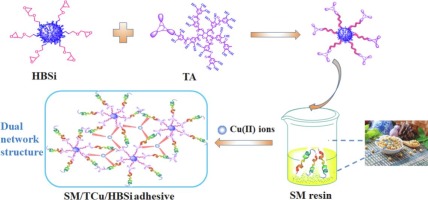Journal of Cleaner Production ( IF 9.7 ) Pub Date : 2020-01-14 , DOI: 10.1016/j.jclepro.2020.120143 Shicun Jin , Kuang Li , Qiang Gao , Wei Zhang , Hui Chen , Jianzhang Li , Sheldon Q. Shi

|
The development of high-performance and sustainable bio-based adhesives has become a significant strategy for solving concerns regarding environmental pollution, resource utilization, and public health in the material engineering and production industries. In this work, hyperbranched silicone was prepared and reacted with a catecholamine-based tannic acid and soybean meal to obtain a strong and antibacterial bio-based adhesive having a hyperbranched cross-linked structure. In addition, versatile copper ions were introduced into the adhesive to form multiple interfacial coordination bonds. The resulting intertwined dual network of metal coordination bonds and covalent crosslinks in the adhesive system improved the cross-link density and cohesive interactions of the adhesives, enhancing their adhesion strength and water resistance. The maximum wet shear strength of the modified adhesive was 1.27 MPa, which was 309.68% higher than that of the pristine adhesive. Sol-gel test showed that the swelling ratio of the modified adhesive decreased from 413.8% to 52.4%, while the insoluble fraction increased by 16.47%. Furthermore, the resulting adhesives exhibited a high bacterial resistance against Staphylococcus aureus and Escherichia coli. The formation of an intertwined dual network in a bio-based adhesive to achieve excellent properties is a promising approach for the fabrication of sustainable eco-friendly biopolymer materials from agricultural byproducts used to achieve a cleaner production.
中文翻译:

多种交联策略可实现双网大豆胶粘剂的高粘结强度和抗菌性能
高性能和可持续的生物基粘合剂的开发已成为解决材料工程和生产行业中有关环境污染,资源利用和公共卫生的问题的重要战略。在这项工作中,制备了超支化有机硅,并使之与儿茶酚胺基单宁酸和豆粕反应,以获得具有超支化交联结构的强力且抗菌的生物基粘合剂。另外,将通用铜离子引入粘合剂中以形成多个界面配位键。粘合剂体系中最终形成的金属配位键和共价交联双链交织网络改善了粘合剂的交联密度和内聚相互作用,从而增强了其粘合强度和耐水性。改性粘合剂的最大湿剪切强度为1.27 MPa,比原始粘合剂的最大湿剪切强度高309.68%。溶胶-凝胶试验表明,改性胶粘剂的溶胀率从413.8%降低到52.4%,而不溶物的溶胀率提高了16.47%。此外,所得的粘合剂对细菌显示出高的细菌抵抗力。金黄色葡萄球菌和大肠杆菌。在生物基粘合剂中形成缠结的双网状结构以实现优异的性能,是一种用于从农业副产品制造可持续的生态友好型生物聚合物材料的有前途的方法,以实现清洁生产。











































 京公网安备 11010802027423号
京公网安备 11010802027423号